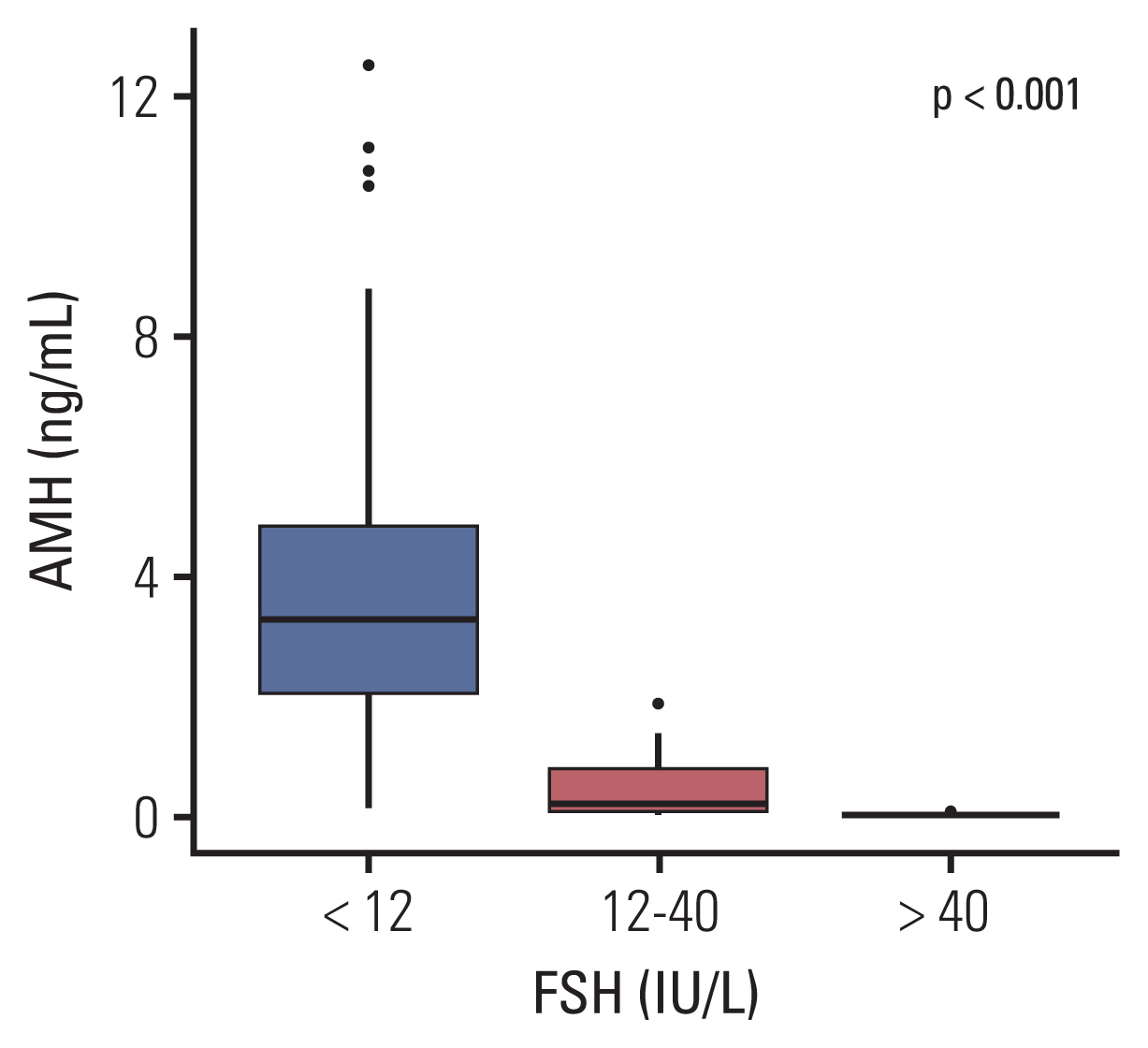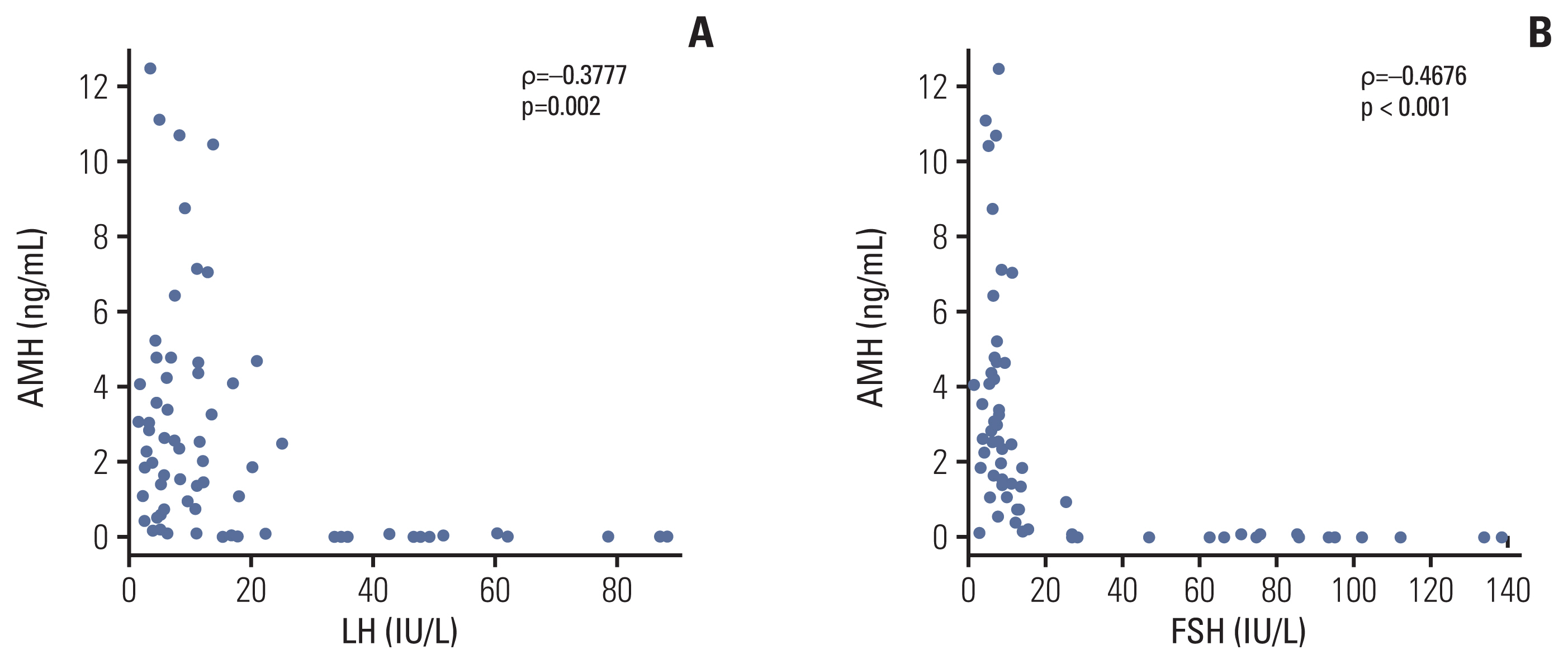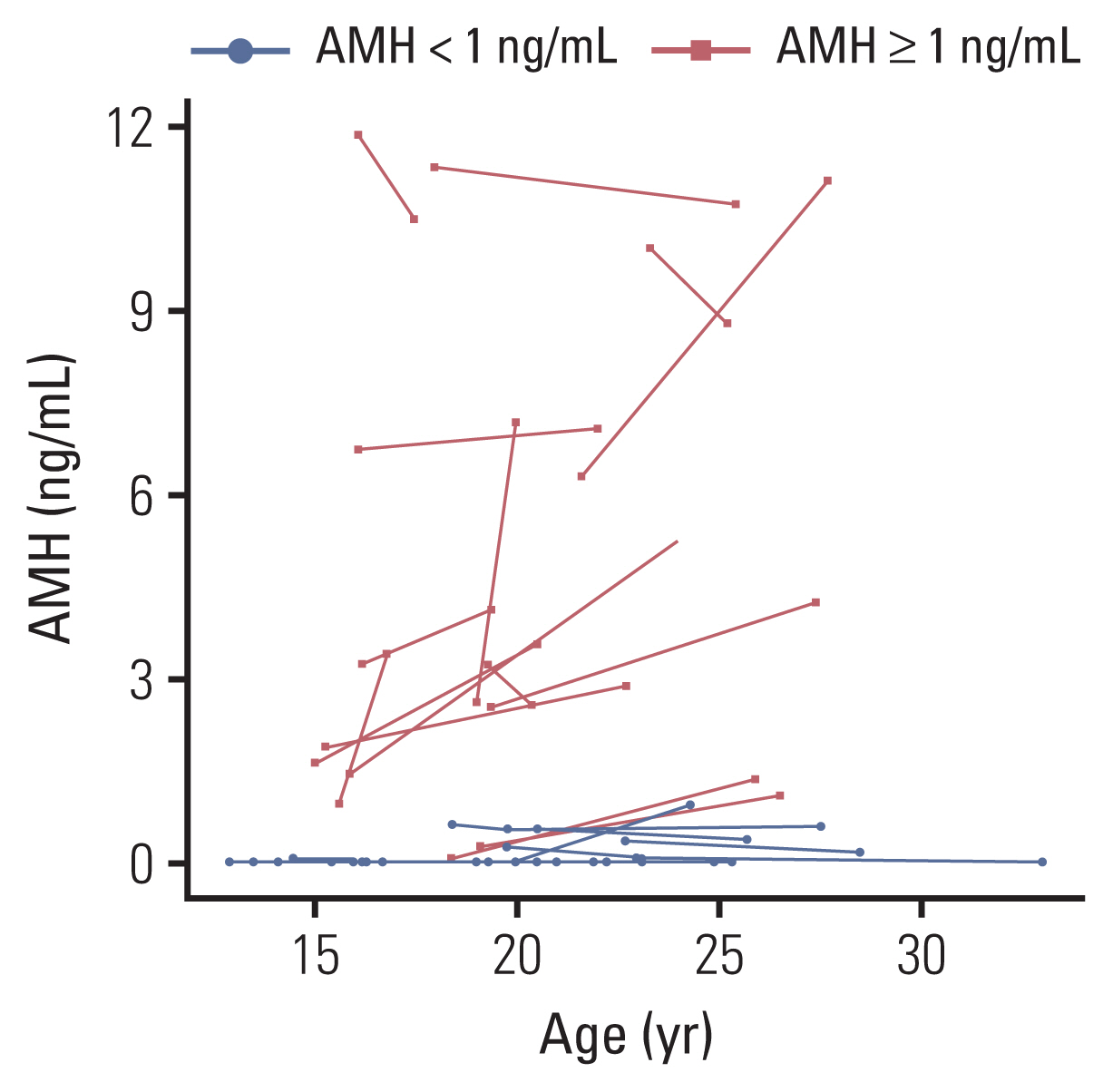Cancer Res Treat.
2023 Jul;55(3):992-1000. 10.4143/crt.2022.1518.
Gonadal Function in Female Adolescent and Young Adult Survivors of Childhood Cancer
- Affiliations
-
- 1Department of Pediatrics, Center for Pediatric Cancer, National Cancer Center, Goyang, Korea
- KMID: 2544179
- DOI: http://doi.org/10.4143/crt.2022.1518
Abstract
- Purpose
Childhood cancer survivors (CCSs) are at risk for premature ovarian insufficiency (POI). The aim of this study is to evaluate ovarian function and associated health outcomes in female adolescent and young adult survivors of childhood cancer.
Materials and Methods
Sixty-nine female CCSs were enrolled. Medical records of CCSs were retrospectively reviewed. The subjects were categorized into three groups according to follicular stimulating hormone (FSH) levels (cutoff, 12, 40 IU/L). Anti-müllerian hormone (AMH) level less than 1 ng/mL was considered low AMH level.
Results
Of 69 subjects, 14 (20.3%) had POI and 14 (20.3%) had FSH levels between 12 and 40 IU/L. Forty-one of 69 (59.4%) had normal FSH levels. Pelvic irradiation and stem cell transplantation (SCT) were more frequently performed in subjects with POI (p=0.001 and p < 0.001). AMH levels were remarkably low when FSH levels were over 12 IU/L (p < 0.001). In multivariate analysis, cyclophosphamide equivalent dose and SCT were significant treatment factors for developing low AMH levels (p=0.005 and p=0.002, respectively). Total, low-density lipoprotein cholesterol and triglyceride were significantly different in three groups according to FSH levels (p=0.047, p=0.030, and p=0.045). Z-score of femur neck bone mineral density was significantly reduced when FSH levels were increased (p=0.011).
Conclusion
Gonadal dysfunction is common in CCSs. Gonadal function was associated with a few treatment factors known to increase the risk of POI. Regular monitoring of gonadal function is needed for better health outcomes.
Keyword
Figure
Reference
-
References
1. van Santen HM, van den Heuvel-Eibrink MM, van de Wetering MD, Wallace WH. Hypogonadism in children with a previous history of cancer: endocrine management and follow-up. Horm Res Paediatr. 2019; 91:93–103.
Article2. Dwyer AA, Phan-Hug F, Hauschild M, Elowe-Gruau E, Pitteloud N. Transition in endocrinology: hypogonadism in adolescence. Eur J Endocrinol. 2015; 173:R15–24.
Article3. Chemaitilly W, Li Z, Krasin MJ, Brooke RJ, Wilson CL, Green DM, et al. Premature ovarian insufficiency in childhood cancer survivors: a report from the St. Jude Lifetime Cohort. J Clin Endocrinol Metab. 2017; 102:2242–50.
Article4. Clark RA, Mostoufi-Moab S, Yasui Y, Vu NK, Sklar CA, Motan T, et al. Predicting acute ovarian failure in female survivors of childhood cancer: a cohort study in the Childhood Cancer Survivor Study (CCSS) and the St Jude Lifetime Cohort (SJLIFE). Lancet Oncol. 2020; 21:436–45.
Article5. Hudson MM, Bhatia S, Casillas J, Landier W; Section On Hematology/Oncology, Children’s Oncology Group, American Society of Pediatric Hematology/Oncology. Long-term follow-up care for childhood, adolescent, and young adult cancer survivors. Pediatrics. 2021; 148:e2021053127.
Article6. Andersen CY, Schmidt KT, Kristensen SG, Rosendahl M, Byskov AG, Ernst E. Concentrations of AMH and inhibin-B in relation to follicular diameter in normal human small antral follicles. Hum Reprod. 2010; 25:1282–7.
Article7. Hagen CP, Aksglaede L, Sorensen K, Main KM, Boas M, Cleemann L, et al. Serum levels of anti-Mullerian hormone as a marker of ovarian function in 926 healthy females from birth to adulthood and in 172 Turner syndrome patients. J Clin Endocrinol Metab. 2010; 95:5003–10.8. Elchuri SV, Patterson BC, Brown MR, Buchanan I, Mertens AC, Meacham LR. Anti-Mullerian hormone levels in American girls by age and race/ethnicity. J Pediatr Endocrinol Metab. 2015; 28:189–93.
Article9. Kanakatti Shankar R, Dowlut-McElroy T, Dauber A, Gomez-Lobo V. Clinical utility of anti-Mullerian hormone in pediatrics. J Clin Endocrinol Metab. 2022; 107:309–23.
Article10. Lunsford AJ, Whelan K, McCormick K, McLaren JF. Antimullerian hormone as a measure of reproductive function in female childhood cancer survivors. Fertil Steril. 2014; 101:227–31.11. Elchuri SV, Patterson BC, Brown M, Bedient C, Record E, Wasilewski-Masker K, et al. Low anti-Mullerian hormone in pediatric cancer survivors in the early years after gonadotoxic therapy. J Pediatr Adolesc Gynecol. 2016; 29:393–9.12. Daan NM, Muka T, Koster MP, Roeters van Lennep JE, Lambalk CB, Laven JS, et al. Cardiovascular risk in women with premature ovarian insufficiency compared to premenopausal women at middle age. J Clin Endocrinol Metab. 2016; 101:3306–15.
Article13. Popat VB, Calis KA, Vanderhoof VH, Cizza G, Reynolds JC, Sebring N, et al. Bone mineral density in estrogen-deficient young women. J Clin Endocrinol Metab. 2009; 94:2277–83.
Article14. Demeestere I, Brice P, Peccatori FA, Kentos A, Gaillard I, Zachee P, et al. Gonadotropin-releasing hormone agonist for the prevention of chemotherapy-induced ovarian failure in patients with lymphoma: 1-year follow-up of a prospective randomized trial. J Clin Oncol. 2013; 31:903–9.
Article15. Burger HG, Dudley EC, Hopper JL, Groome N, Guthrie JR, Green A, et al. Prospectively measured levels of serum follicle-stimulating hormone, estradiol, and the dimeric inhibins during the menopausal transition in a population-based cohort of women. J Clin Endocrinol Metab. 1999; 84:4025–30.
Article16. Green DM, Nolan VG, Goodman PJ, Whitton JA, Srivastava D, Leisenring WM, et al. The cyclophosphamide equivalent dose as an approach for quantifying alkylating agent exposure: a report from the Childhood Cancer Survivor Study. Pediatr Blood Cancer. 2014; 61:53–67.
Article17. Kang MJ, Hong HS, Chung SJ, Lee YA, Shin CH, Yang SW. Body composition and bone density reference data for Korean children, adolescents, and young adults according to age and sex: results of the 2009–2010 Korean National Health and Nutrition Examination Survey (KNHANES). J Bone Miner Metab. 2016; 34:429–39.
Article18. Chow EJ, Antal Z, Constine LS, Gardner R, Wallace WH, Weil BR, et al. New agents, emerging late effects, and the development of precision survivorship. J Clin Oncol. 2018; 36:2231–40.
Article19. Kremer LC, Mulder RL, Oeffinger KC, Bhatia S, Landier W, Levitt G, et al. A worldwide collaboration to harmonize guidelines for the long-term follow-up of childhood and young adult cancer survivors: a report from the International Late Effects of Childhood Cancer Guideline Harmonization Group. Pediatr Blood Cancer. 2013; 60:543–9.
Article20. van Dorp W, Mulder RL, Kremer LC, Hudson MM, van den Heuvel-Eibrink MM, van den Berg MH, et al. Recommendations for premature ovarian insufficiency surveillance for female survivors of childhood, adolescent, and young adult cancer: a report from the international late effects of childhood cancer guideline harmonization group in collaboration with the PanCareSurFup Consortium. J Clin Oncol. 2016; 34:3440–50.
Article21. Green DM, Sklar CA, Boice JD Jr, Mulvihill JJ, Whitton JA, Stovall M, et al. Ovarian failure and reproductive outcomes after childhood cancer treatment: results from the Childhood Cancer Survivor Study. J Clin Oncol. 2009; 27:2374–81.
Article22. van Dorp W, Haupt R, Anderson RA, Mulder RL, van den Heuvel-Eibrink MM, van Dulmen-den Broeder E, et al. Reproductive function and outcomes in female survivors of childhood, adolescent, and young adult cancer: a review. J Clin Oncol. 2018; 36:2169–80.
Article23. van der Kooi AL, van den Heuvel-Eibrink MM, van Noortwijk A, Neggers SJ, Pluijm SM, van Dulmen-den Broeder E, et al. Longitudinal follow-up in female childhood cancer survivors: no signs of accelerated ovarian function loss. Hum Reprod. 2017; 32:193–200.24. Choi R, Lee SG, Lee EH. Reference intervals of anti-Mullerian hormone in Korean women. J Clin Lab Anal. 2022; 36:e24525.25. Hagen CP, Aksglaede L, Sorensen K, Mouritsen A, Andersson AM, Petersen JH, et al. Individual serum levels of anti-Mullerian hormone in healthy girls persist through childhood and adolescence: a longitudinal cohort study. Hum Reprod. 2012; 27:861–6.26. Anderson RA, Mitchell RT, Kelsey TW, Spears N, Telfer EE, Wallace WH. Cancer treatment and gonadal function: experimental and established strategies for fertility preservation in children and young adults. Lancet Diabetes Endocrinol. 2015; 3:556–67.
Article27. Thomas-Teinturier C, El Fayech C, Oberlin O, Pacquement H, Haddy N, Labbe M, et al. Age at menopause and its influencing factors in a cohort of survivors of childhood cancer: earlier but rarely premature. Hum Reprod. 2013; 28:488–95.
Article28. Oktay K, Harvey BE, Partridge AH, Quinn GP, Reinecke J, Taylor HS, et al. Fertility preservation in patients with cancer: ASCO clinical practice guideline update. J Clin Oncol. 2018; 36:1994–2001.
Article29. Su HI, Kwan B, Whitcomb BW, Shliakhsitsava K, Dietz AC, Stark SS, et al. Modeling variation in the reproductive lifespan of female adolescent and young adult cancer survivors using AMH. J Clin Endocrinol Metab. 2020; 105:2740–51.
Article30. Kim S, Kim SW, Han SJ, Lee S, Park HT, Song JY, et al. Molecular mechanism and prevention strategy of chemotherapy- and radiotherapy-induced ovarian damage. Int J Mol Sci. 2021; 22:7484.
Article31. Younis JS, Naoum I, Salem N, Perlitz Y, Izhaki I. The impact of unilateral oophorectomy on ovarian reserve in assisted reproduction: a systematic review and meta-analysis. BJOG. 2018; 125:26–35.
Article32. Lehmann V, Chemaitilly W, Lu L, Green DM, Kutteh WH, Brinkman TM, et al. Gonadal functioning and perceptions of infertility risk among adult survivors of childhood cancer: a report from the St Jude Lifetime Cohort Study. J Clin Oncol. 2019; 37:893–902.
Article33. van der Perk ME, Broer L, Yasui Y, Robison LL, Hudson MM, Laven JSE, et al. Effect of genetic variation in CYP450 on gonadal impairment in a European cohort of female childhood cancer survivors, based on a candidate gene approach: results from the PanCareLIFE Study. Cancers (Basel). 2021; 13:4598.
Article34. van der Kooi AL, Clemens E, Broer L, Zolk O, Byrne J, Campbell H, et al. Genetic variation in gonadal impairment in female survivors of childhood cancer: a PanCareLIFE study protocol. BMC Cancer. 2018; 18:930.
Article35. Jin HY, Lee JA. Low bone mineral density in children and adolescents with cancer. Ann Pediatr Endocrinol Metab. 2020; 25:137–44.
Article36. Almeida M, Laurent MR, Dubois V, Claessens F, O’Brien CA, Bouillon R, et al. Estrogens and androgens in skeletal physiology and pathophysiology. Physiol Rev. 2017; 97:135–87.
Article37. Fahed AC, Gholmieh JM, Azar ST. Connecting the lines between hypogonadism and atherosclerosis. Int J Endocrinol. 2012; 2012:793953.
Article
- Full Text Links
- Actions
-
Cited
- CITED
-
- Close
- Share
- Similar articles
-
- Gonadal and Sexual Dysfunction in Childhood Cancer Survivors
- Gonadal Function in Female Childhood Cancer Survivors
- Grieving among Adolescent Survivors of Childhood Cancer: A Situational Analysis
- Long-term follow-up study and long-term care of childhood cancer survivors
- Late physical effects of childhood cancer survivors




